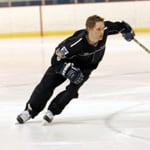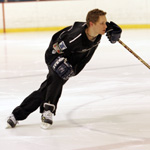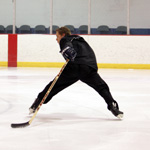Crossovers are the maneuvers that enable players to accelerate on curves, circles and corners. They make it possible for players to generate speed for the straight-aways, to weave in and out of traffic, to zigzag down the ice, change direction, turn from backward to forward, and move laterally (from side to side) and to fake ("deke"). Powerful, fast and quick crossovers are essential for all hockey players. "Crossover" refers to the passing of the outside skate (the one nearer the outside of the curve)over (in front of) the toe of the inside skate.
Skating on circles and curves (which are actually segments of circles) involves powerful forces that tend to oppose the skaters desired directionality.
Centripetal force is the force that keeps the player skating in a circular path instead of "flying out" of the circle on a line tangent to the circle. Centripetal force is created by the blades thrusting against the ice (toward the center of the circle) at a strong angle.
As the skater's lower body (skates, knees, hips) leans inward, which is necessary in order to skate a circular path, gravitational forces work to make the skater fall. The object of the skater is to keep the curve tight and to minimize wasted distance (along the tangent line) while remaining upright and balanced while executing tight curves and circles.
While performing forward and backward crossovers, the edges of the skates ride on the periphery of the circle. Edges and knee bend are deep. The entire lower body (edges, knees, and hips) leans into circle at a strong angle. To prevent a fall the upper body (torso, shoulders, and head)must be situated directly above the center of gravity. The center of gravity is (and by necessity must be) located directly above the skates. To balance over the center of gravity the skater must "counter- lean" with the upper body (lean slightly toward the outside of the circle). By counter-leaning, the upper body will be situated above the center of gravity (skates). The lower body can now safely lean into the circle to skate the circle or curve.
Basic to all Crossovers

- "Crossover" refers to the passing of the outside skate (the one nearer the outside of the curve) over (in front of) the toe of the inside skate.
- Forward and backward crossovers are very similar.
- Knee bend: Ideal knee bend is a 90 degree angle, when measured between thigh and shin.
- Edges (Angulation): Skates, knees and hips press into curve or circle. Angle of engaged skate blade to the ice at speed and on sharp curves is 45 degrees.
- Upper body: Shoulders are held level to the ice, and even slightly counter-leaned (inside shoulder higher than outside shoulder). Upper body does not tilt (lean) into the circle.
- Shoulders are held still – they do not swing or move around while performing crossovers.
- Skates are always in the same place in relationship to the hips – they skate under the outside hip – therefore weight is always balanced over the outside skate. Weight does not shift forward/back or side to side.
- Push first, change feet second – must always push before stepping onto new skate.
- Weight transfer from pushing skate to gliding skate (and vice-versa) takes place at midpoint of the push, not sooner.

- Skates stay within one inch of the ice at all times.
- Pushes are outward/inward, not forward/backward.
- Toe of pushing skate never points straight downward.
Body Position and Control in Crossovers
A player's ability to move at speed while skating on a curve or circle is affected by the position and control of the upper body.
- Hips and skates always face the direction of travel.
- Shoulders remain quiet and level with the ice.
- Excessive arm, chest, shoulder, and head movement affect balance, agility, and maneuverability (BAM), and the ability to control the puck.
- The upper body "twists" approximately one quarter turn in opposition to the hips. This is called torque.
- Two upper-body positions are used when performing forward crossovers:
- Chest and shoulders face toward the center of the curve or circle.
- Chest and shoulders face away from the center of the curve or circle.
- Only one upper body position is used when performing backward crossovers:
- Chest and shoulders face toward the center of the curve or circle.
Points for Forward Crossovers.
- While gliding on the outside edge of the inside skate, body weight must be on the back half of the blade. If weight is too far forward, the outside edge cannot cut into the ice; the skate will fishtail into a skid, causing a loss of grip against the ice and a subsequent loss of balance. Even a deeply edged skate will skid if the body weight is too far forward above the outside edge.
- The tighter the curve and the greater the speed, the more the weight must be on the back half of the outside edge.
- Entire blade length of each gliding skate must be in complete contact with the ice. It is impossible to balance with the weight on just part of the blade.
- Thrust against the edges with powerful and full leg drive. Small hopping steps take you nowhere fast; jumping upward destroys forward momentum.
- For quick acceleration, skaters often run the first one or two crossover sequences on the toes (fronts of the edges). However, even while running the crossovers, body weight must stay low and projected outward in the desired direction of travel.
- The process of crossing the inside skate under the body to push is much more pronounced than the process of crossing the outside skate over the inside skate to glide.
Points for Backward Crossovers

- Simultaneously with the C-cut push and while the inside skate is still off the ice, skater reaches the inside skate and leg sideways into the circle. When the inside skate takes the ice, the feet are wider apart than shoulders.
- The X push is executed as if the inside skate and leg were scooping the circle (pulling the ice) underneath the body.
- The X push is outside the body before skater begins to cross over. If skater crosses over prematurely, skates can hit each other during the cross over.
- Body weight is over the front halves of the blades, but entire blade lengths of both skates must stay in contact with the ice.
- Posture: If skater leans too far forward, body weight will pitch over the toes. Skater should not need to lean on hockey stick for balance.
Points for Forward and Backward Crossovers.
- Body weight is always above the outside skate; the skates change underneath the body.
- No forward/backward change of weight, no side-to-side change of weight.
- Hips and skates stay parallel to (facing) the line of travel during the entire crossover maneuver. If a skate takes the ice in a different direction than the line of travel (i.e., sideways), skater is forced to go that way.
- The process of crossing the inside skate under the body to push is more pronounced than the process of crossing the outside skate over in front of the inside skate.
- If the scissoring action is executed properly, the legs cross at the tops of the thighs, not just at the knees.
- Goalies too must complete the X push. Driving the leg well under the body creates room for the skate to cross beyond the bulky pads.
Practice Drills for Forward and Backward Crossovers
- Skater practices forward crossovers, holding the hockey stick with both hands. The stick stays on the ice in its correct position for controlling a puck while skating on circles. The stick should not move around.
- Skater practices this on both forehand and backhand sides.
- Skater practices this on forehand and backhand sides while controlling a puck.
- Skater practices forward crossovers, holding the hockey stick with just the top hand. Then skater practices forward crossovers holding hockey stick with just the top hand while keeping the puck on the stick.
- The above drills should be practiced using upper body position #1 and #2.
- Skater practices backward crossovers, holding the hockey stick with just the top hand. Then skater practices backward crossovers holding hockey stick with just the top hand while keeping the puck on the stick.
- Skater practices backward crossover drills using upper body position #1.
- Skater practices moving laterally down the ice without, then with a puck.
Balance on crossovers is a learned skill. It takes lots of experimentation and lots of practice. You may take several falls in the process of mastering it so be sure to wear a helmet and other protective hockey gear. When you master balancing on crossovers you'll be amazed at how much faster you'll be able to skate circles and how much better your balance will be.
by Laura Stamm © November, 2004